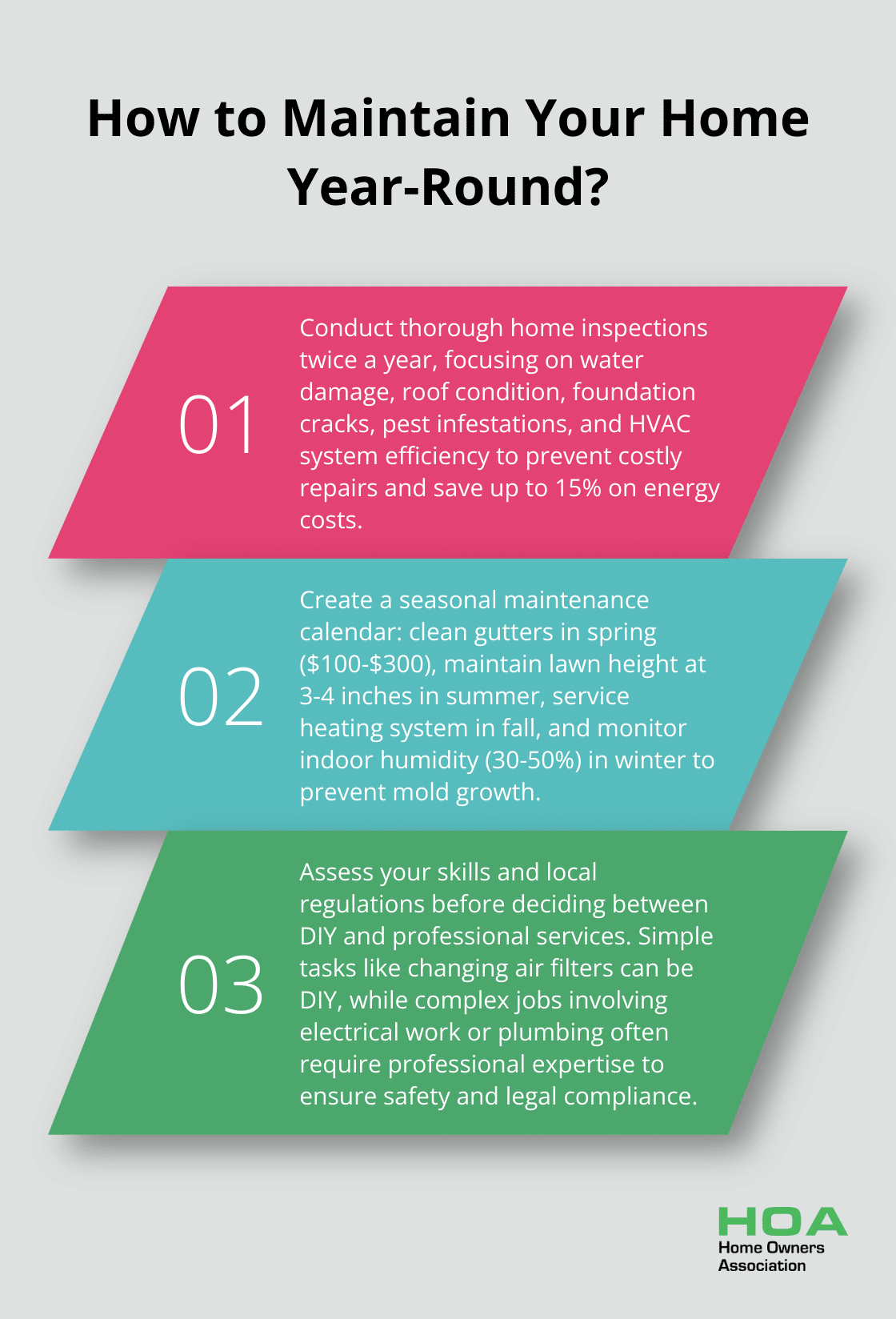
At Home Owners Association, we understand that becoming a new homeowner is an exciting journey. However, it also comes with the responsibility of maintaining your property.
Our new home maintenance tips will help you protect your investment and keep your house in top shape. From regular inspections to seasonal tasks, we’ll guide you through the essentials of home upkeep.
How to Conduct Regular Home Inspections
Regular home inspections form the foundation of effective property maintenance. We recommend you perform thorough inspections at least twice a year to identify potential issues early and prevent costly repairs.
Detecting Water Damage and Leaks
Water damage poses one of the most insidious threats to your home. Start your inspection by examining ceilings, walls, and floors for discoloration, warping, or soft spots. Focus on areas around windows, doors, and plumbing fixtures. The average insurance payout for water damage to a home is $11,605. Don’t overlook areas under sinks and around toilets for signs of leakage.
Roof and Gutter Maintenance
Your roof serves as your home’s first line of defense against the elements. Inspect it for missing, cracked, or curling shingles. Look for signs of sagging, which could indicate structural issues. Clean your gutters at least twice a year to prevent water from backing up and damaging your roof or foundation. According to the National Association of Home Builders (NAHB), about 85% of homes experience basement water problems.
Foundation Assessment
A solid foundation ensures your home’s structural integrity. Walk around the exterior of your house and look for cracks in the foundation or gaps where it meets the ground. Inside, check for cracks in walls, especially around door frames and windows. The American Society of Home Inspectors notes that vertical cracks less than 1/8 inch wide generally don’t cause concern, but horizontal cracks or those wider than 1/4 inch require professional evaluation.
Pest Infestation Check
Pests can cause significant damage to your home if left unchecked. Inspect your property for signs of unwanted guests such as termites, carpenter ants, or rodents. Look for wood damage, droppings, or unusual noises in walls. The National Pest Management Association reports that termites alone cause over $5 billion in property damage annually in the United States.
HVAC System Evaluation
Your heating, ventilation, and air conditioning (HVAC) system requires regular maintenance to function efficiently. Check and replace filters every 1-3 months (depending on usage and type). Inspect visible ductwork for leaks or disconnections. The U.S. Department of Energy suggests that proper HVAC maintenance can reduce energy consumption by up to 15%, leading to significant cost savings.

As we move forward to discuss seasonal maintenance tasks, keep in mind that these regular inspections lay the groundwork for a year-round maintenance strategy. By staying proactive with these checks, you’ll be well-prepared to tackle the specific challenges each season brings to your home.
Seasonal Home Care Calendar
At Home Owners Association, we understand the importance of year-round home maintenance. Our seasonal home care calendar will help you protect your investment and keep your property in top condition throughout the year.
Spring Renewal
Spring is the perfect time to assess winter damage and prepare for warmer weather. Start with a roof inspection to check for loose or damaged shingles. The National Roofing Contractors Association recommends this task when temperatures range between 45 and 85 degrees Fahrenheit, which allows for proper sealing of asphalt shingles.
Clean your gutters thoroughly to prevent water damage. On average, homeowners can expect to pay between $100 and $300 for a professional gutter cleaning service. While you’re at it, inspect your eaves and attic for signs of pest infestation.

Don’t forget to service your air conditioning system. The U.S. Department of Energy states that proper maintenance can reduce cooling energy costs by up to 15%. Schedule a professional inspection or, at minimum, replace filters and clean condenser coils.
Summer Upkeep
Summer focuses on outdoor maintenance. Pay attention to your lawn and garden, ensuring proper watering and trimming. The National Association of Landscape Professionals suggests mowing your lawn to a height of 3 to 4 inches for deeper root growth and drought resistance.
This season is ideal for sealing air leaks around windows and doors. The U.S. Environmental Protection Agency estimates that homeowners can save an average of 15% on heating and cooling costs through proper air sealing and insulation.
Maintain your home’s exterior by power washing siding and decks to prevent mold and mildew growth. (Home Owners Association members can access discounted rates on power washing equipment and other maintenance tools.)
Fall Preparations
As temperatures drop, prepare your home for winter. Start with an inspection and service of your heating system. The American Society of Home Inspectors notes that furnaces typically last 15-20 years, but regular maintenance can extend this lifespan significantly.
Winterize outdoor spaces by draining and storing hoses, shutting off exterior faucets, and cleaning and covering patio furniture. If you have a fireplace, clean your chimney. The Chimney Safety Institute of America recommends annual inspections to prevent dangerous chimney fires.
Check your attic insulation. The North American Insulation Manufacturers Association states that proper insulation can save homeowners up to 20% on heating and cooling costs.
Winter Vigilance
Winter brings unique challenges for homeowners. Ice dams, which form when heat escapes through the roof and melts snow, can cause significant damage. Ensure proper attic insulation and ventilation to maintain a consistent roof temperature and prevent these costly issues. Attic ventilation can reduce the likelihood of ice dam formation by cooling the roof deck.
Monitor your home’s humidity levels during winter. The Environmental Protection Agency recommends keeping indoor humidity between 30% and 50% to prevent condensation and mold growth. Use a hygrometer to measure humidity and consider a dehumidifier if levels are too high.
Stay alert for drafts. The U.S. Department of Energy reports that drafts can waste 5% to 30% of your energy use. Check for cold air around windows and doors, and use weatherstripping or caulk to seal any leaks.
As we transition from seasonal maintenance to the next crucial aspect of home care, it’s important to consider which tasks you can handle yourself and which require professional expertise. Let’s explore the balance between DIY and professional maintenance in the next section.
DIY or Pro: Making the Right Choice for Home Maintenance
Assessing Your Skills and Time
As homeowners, we often face the dilemma of whether to tackle maintenance tasks ourselves or hire professionals. Simple tasks like changing air filters, unclogging drains, or painting a room are generally safe DIY projects. However, more complex jobs involving electrical work, plumbing, or structural changes often require professional expertise.
Cost Considerations
DIY can save money, but it’s not always the most cost-effective option. A professional gutter cleaning service might cost $100-$300, but attempting this task without proper safety equipment could lead to a costly hospital visit. On the other hand, painting a room yourself could save you $200-$300 per room compared to hiring a professional.
Safety and Legality
Some maintenance tasks are not just about skill, but also about safety and legal compliance. Electrical work, for instance, often requires permits and inspections. The Electrical Safety Foundation International warns that home electrical fires account for an estimated 51,000 fires each year, nearly 500 deaths, more than 1,400 injuries, and $1.3 billion in property damage. Always consult local regulations before attempting any major electrical, plumbing, or structural work.
Professional Services and Estimates
Many contractors offer free estimates, allowing you to weigh the costs and benefits before making a decision. This can help you make informed choices that keep your home in top condition while managing your budget effectively.
Tools and Equipment
Consider the tools and equipment needed for a task. Some projects require specialized tools that you may not own or know how to use properly. In these cases, hiring a professional who already has the necessary equipment can be more cost-effective than purchasing or renting tools for a one-time use.

Final Thoughts
Home maintenance requires attention, effort, and planning. Our new home maintenance tips help you protect your investment and keep your property in top condition. You will avoid costly repairs and maintain a safe, comfortable living environment by addressing small issues early.

We recommend you create a personalized maintenance schedule that fits your home’s specific needs and your lifestyle. Consider your home’s age, local climate, and personal skills when you plan your maintenance routine. Consistency in home maintenance yields significant results over time.
Home Owners Association supports homeowners in Melbourne, Australia, with their maintenance needs. Our members receive trade pricing, discounts on materials, and expert advice (ensuring their home projects meet high standards). We guide you through every step of your home maintenance journey, whether you tackle DIY tasks or work with professionals.





